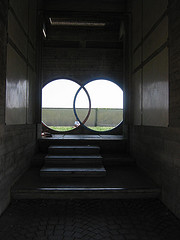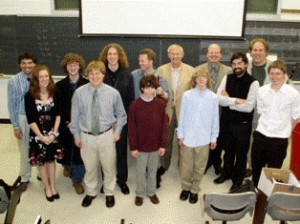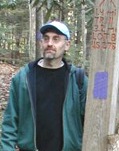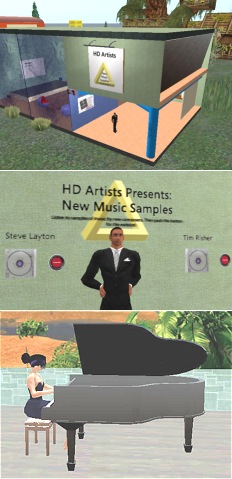Today is National Record Store Day. Music sellers throughout the country are celebrating in a variety of ways, from special sales and promotions to instore performances. Given the challenges that have faced “brick and mortar” record stores in recent years – internet retailers, digital downloading, and plummeting CD sales among them – I’m glad there’s a day to celebrate with the people who’ve helped me find many musical treasures. To find out if your local retailer is participating, visit www.recordstoreday.com.
by Patrick Durek
Since its inception in 1985, Cygnus Ensemble has been at the forefront of chamber groups dedicated to expanding the repertory. Generating works for subsets of its unorthodox instrumentation—two guitars, cello, oboe, flute, and violin—has been its primary mission, and while premieres by well-known composers (Charles Wuorinen, Meyer Kupferman, and Milton Babbitt) have been given, it is the group’s championing of works by up-and-coming composers that has perhaps been most significant. Robert Martin, Jonathan Dawe, and Robert Pollock have all written multiple works for Cygnus Ensemble and are now firmly rooted in the Northeastern milieu that Wuorinen, Kupferman, and Babbitt had for so long dominated.
The group has a dynamic that has, for the past two decades, given it a credence that many other new music ensembles lack, making it an attractive premiere-vehicle for the established composer and a coveted marketing entity for the aspiring composer. Part of this dynamic is created by impeccable musicianship: each member not only possesses mastery over his or her instrument, but a depth of experience performing new music. Another element has been the ensemble’s willingness to experiment with different modes of advertising and programming.
Cygnus Ensemble is, ironically, both traditional (it typically eschews the now ubiquitous attention-grabbing concerts that incorporate dance, poetry, costumes, and slide shows; it usually gives evening concerts at established classical music bastions such as Merkin Concert Hall and Symphony Space), and progressive (it is not uncommon for a concert to feature works solely by esoteric composers—no traditional music thrown in for sweetening effect). It might sound as if Cygnus Ensemble caters to connoisseurs of the avant-garde, composers, and musicologists. And it does. But it also fills seats: their last concert, at Weill Hall, on March 8, sold out. The secret ingredient? In part, an embrace of Internet technology.
William Anderson, Cygnus Ensemble’s founder and guitarist, explains the group’s success as a result of outreach via new media. “Most groups just try to get composers to come,” he says. “We have advertised extensively, directing traditional listeners to our Web site, where they can listen to sound clips, watch videos, and hear interviews. Outlets such as YouTube give the ticket-buying public a new point-of-entry into a new work.”
 Cygnus Ensemble’s upcoming concert, at Merkin Concert Hall, on April 23, at 8 pm, features new works by Yehudi Wyner, Harold Meltzer, Mario Davidovsky, and Chester Biscardi. Such a program might frighten the non-new music fanatic, but it doesn’t have to. A tentative but curious music aficionado can visit cygnusensemble.com, and get acquainted with the composers and their works. One might be surprised to learn, for instance, that both Yehudi Wyner and Mario Davidovsky are recipients of Pulitzer Prizes for Music, or that the feature work, Brion, by Harold Meltzer, was inspired by a visit to the Brion-Vega Cemetery, in San Vito d’Altivole, Italy. (A viewing of the YouTube Cemetery Tour, coupled with the accompanying sound clips of both the piece and Meltzer’s verbal descriptions, makes one eager to see the performance of the entire work.)
Cygnus Ensemble’s upcoming concert, at Merkin Concert Hall, on April 23, at 8 pm, features new works by Yehudi Wyner, Harold Meltzer, Mario Davidovsky, and Chester Biscardi. Such a program might frighten the non-new music fanatic, but it doesn’t have to. A tentative but curious music aficionado can visit cygnusensemble.com, and get acquainted with the composers and their works. One might be surprised to learn, for instance, that both Yehudi Wyner and Mario Davidovsky are recipients of Pulitzer Prizes for Music, or that the feature work, Brion, by Harold Meltzer, was inspired by a visit to the Brion-Vega Cemetery, in San Vito d’Altivole, Italy. (A viewing of the YouTube Cemetery Tour, coupled with the accompanying sound clips of both the piece and Meltzer’s verbal descriptions, makes one eager to see the performance of the entire work.)
Designed by the sculptor/designer Carlo Scarpa, Brion-Vega is an eerily austere memorial that juxtaposes large, cold concrete tombs with placid reflecting pools and meticulously manicured lawns. “Seemingly incongruous elements,” as Meltzer notes, “come together to create a sense of peace.” In Brion the musical work, flute (doubling piccolo), oboe, guitar, mandolin, violin, and cello (the instruments themselves also apparently unrelated), engage in a sonic intertwining that ultimately leads to unity. Without the aid of Carlo Scarpa’s Brion YouTube tour, the Brion photographs, and the sound clips, one might have no idea what Brion was. The tendency for all but the most daring would be to skip the Cygnus Ensemble concert in favor of something known. For all the quibbling about Internet technology building a wall around us, there can be no mistake about its potential for elucidating new art for the public.
In addition to Brion, the April 23 concert will include Chester Biscardi’s Traverso, for flute and piano; Romancero, for soprano, flute, clarinet, violin, and cello, which uses anonymous texts by Jewish Sephardim; and Oboe Quartet, by Yehudi Wyner. On the surface, the program appears to be, as Anderson confesses, “more like a new music ghetto program.” However, each work has the potential to be grasped and appreciated by traditional classical music listeners. “Oboe Quartet is sumptuous and will appeal to the Brahms lovers. I think it’s as convincing [as Brahms], but in a new voice.”
Perhaps the salient musical element that unifies the program is the tonal triad. Serving as the sunlight that draws together the tombs, grasses, and waters of Brion-Vega, the triad makes several unexpected appearances in both Brion and Oboe Quartet, shining light on what otherwise might be construed as esoteric avant-garde. “The way everything coalesces around them is striking.” Anderson emphasizes. “I think of these triads as iconic, as uniting all of us. They are fleeting but the impression is there.”
Anybody seen the new Met production of Satyagraha?
[youtube]sMtDI539bvI[/youtube]
 Usually, when thinking of contemporary classical music, one thinks of the rather abstract and cerebral music of the decade right after the Second World War. Some of this so-called serial music in my opinion is very exciting, sometimes purely beautiful, and sometimes incomprehensible. However, one cannot deny that, for the listener, there seem very few similarities or references to any other kind of music, making it hard to appreciate modern music without some thorough study.
Usually, when thinking of contemporary classical music, one thinks of the rather abstract and cerebral music of the decade right after the Second World War. Some of this so-called serial music in my opinion is very exciting, sometimes purely beautiful, and sometimes incomprehensible. However, one cannot deny that, for the listener, there seem very few similarities or references to any other kind of music, making it hard to appreciate modern music without some thorough study.
In a revolt against the lyricism and romanticism of pre-war classical music, young composers such as Boulez and Stockhausen broke with any audible sense of pulse, harmony and melody. In their opinion, writing poetic music after the horrors of two World Wars would not be reflecting society and the state-of-affairs, and besides, a radically new language provided composers with a tool to start with a clean slate, without references to the past. As a performer, learning such works is challenging and exciting. It requires a great deal of both physical practise and mental study to come to grips with the often complex rhythms, and to find a way of phrasing (making musical sentences of) the notes to a more or less logical musical discourse. Besides that, executing all the different and often extremely opposing dynamics per note, which usually are an exceptionally important element of the structure of especially a so-called serial (“mathematical”) composition, requires a great control of touch. The downside of playing this music is that other important playing techniques such as traditional legato-playing, where one ties the notes smoothly together, and “fingery” passagework, are less at the forefront, or not at all.
(more…)
 This past Friday, Westminster Choir College in Princeton, New Jersey hosted a masterclass for the Pictures 2008 project. This competition, sponsored by NJ Arts Collective and the Montclair Art Museum, invited NJ high school and college students to compose works based on a painting in the museum’s collection: Sunset by George Inness (1892). The winning works, as well as my new trio Innesscapes, will be presented on a concert given by the Halcyon Trio at the museum on May 9th at 8 PM. The event also features a pre-concert talk with Inness scholar Adrienne Baxter-Bell at 7:15.
This past Friday, Westminster Choir College in Princeton, New Jersey hosted a masterclass for the Pictures 2008 project. This competition, sponsored by NJ Arts Collective and the Montclair Art Museum, invited NJ high school and college students to compose works based on a painting in the museum’s collection: Sunset by George Inness (1892). The winning works, as well as my new trio Innesscapes, will be presented on a concert given by the Halcyon Trio at the museum on May 9th at 8 PM. The event also features a pre-concert talk with Inness scholar Adrienne Baxter-Bell at 7:15.
At the masterclass, both the winners and the runners-up met with the Halcyon Trio: Andrew Lamy, Brett Deubner, and Gary Kirkpatrick (www.Halcyontrio.com). The trio discussed issues of orchestration, notation, and interpretation with the composers, giving them valuable feedback about their work. Whether the composer in question was a 13 year-old middle school student or a college-level composition major, the trio members treated them and their music with professionalism and enthusiasm. Gary Schneider from museum’s education department gave an insightful presentation discussing Inness’ landscape paintings. All in all, it was a most exciting and successful day for the next generation of NJ composers.
Pictured: Halcyon Trio members Brett Deubner, Andrew Lamy, and Gary Kirkpatrick, composer Christian Carey, Montclair Art Museum Education Director Gary Schneider, and student winners David Zas (Rider U.) Michael Mikulka (Rutgers U.), Thomas Oltarzewski (Montclair State U.), Rachael Chastain (Pennsville HS), Ian Vogler (Lakewood HS), Daniel Konstantinovsky (Tenafly Middle School), Tim Vorderstrasse (Midland Park HS), and Sam Skinner (Glen Field Middle School, Montclair).
Photo: Kimberly Burja
I heard Gabriel Kahane at Joe’s Pub Wednesday night. If Billy Joel and Paul McCartney can write “classical music”, why can’t composers write “pop music”?
1. Gabe Kahane is a good singer, great pianist and out of this world showman. His wry and wonderful wit comes through his music and lyrics. Wednesday night Kahane shared his sounds with humor, humility and always in an entertaining way.
2. Ensemble with the four man band, including: piano, banjo, violin, clarinet, bass clarinet, drums, guitar, electric bass, toy piano and a melodic, was generally tight and toe tapping. Less stellar was the drummer playing banjo – it just didn’t click and wasn’t heard very well – perhaps it was his trip from Seattle. Later when Kahane picked up the banjo, it was heard fine and in time!
3. Rob Moose played excellent lines whether it was on violin, guitar or bass. Also Sam Sadigursky shone in his bass clarinet lines, and as a toy pianist, rocked the joint.
4. New songs including Keen were charming, including a Pan-Am bag on the subway inspired song written that day – although the riffs were cool, the selections weren’t always memorable.
5. The highlight of the evening was Kahane’s Craiglistlieder, a 21st Century masterpiece, both a virtuoso vehicle for Gabe singing and playing, and a biting commentary. Operatic riffs including pseudo recitative and rhythmic variety made this in a word, perfect.
The show was short but sweet – keep an eye out for the new album in August and go to http://www.gabrielkahane.com/ to experience the Craiglistlieder for yourself, you’ll be glad you did!
 Tim Risher is a composer that I bumped into a long time ago on this here web thingy. His illustrious career has taken him from making new music in Florida, to a long stint producing radio in Germany, to currently doing — well, something or other — in deepest, darkest Durham, North Carolina.
Tim Risher is a composer that I bumped into a long time ago on this here web thingy. His illustrious career has taken him from making new music in Florida, to a long stint producing radio in Germany, to currently doing — well, something or other — in deepest, darkest Durham, North Carolina.
One of Tim’s latest personal ventures involves the wildly-popular virtual world of Second Life. There, people seem to carry on just like they do out here in the real world, except they get to make it — and even themselves — into anything they can dream up. Like the Royal Liverpool Philharmonic, which gave a “virtual” concert in there just last autumn.
 What Tim has dreamed up in his own little patch of turf within Second Life, is a place called HD Artists (for you folks who already wander this alternate world, here’s a link directly to his place). I’ll let Tim himself explain:
What Tim has dreamed up in his own little patch of turf within Second Life, is a place called HD Artists (for you folks who already wander this alternate world, here’s a link directly to his place). I’ll let Tim himself explain:
HD Artists is a virtual New Music center in Second Life. The center has only just opened, but we plan on having:
A wall of CD players letting you hear music samples of different composers along with a link to their website.
Links to various publishers of new music.
Soon we hope to present live performances at our building as well, this will take a while to suss out, though.
Going to places in Second Life is a lot like walking around in a 3D blog, or better, a 3D fashion magazine. And visiting concerts there are just like, well, a 19th-century fashion magazine salon. But the concerts are quite enjoyable, it is really like listening to a real-life concert (which, in fact, that’s what it is), but with all the trappings of Second Life.
If you’re interested in learning more about HD Artists or would like a link there, feel free to contact me.
Tim asked me if I’d like to have my own music up in the place (even though I don’t hang in that particular world just yet), and I said sure, why not? If you’re ready to go virtual, send Tim an email at timrisher@googlemail.com. Maybe we’ll all get two free virtual tickets to the inaugural concert…
Okay, listen up. This is important. The American Music Center (AMC) and American Composers Forum (ACF) have teamed up with Columbia University’s Research Center for Arts and Culture to conduct the first major study of living composers. Since many Sequenza21 readers are, in fact, living and do write music, that means you. The study, they say, aims to gather important data to guide their efforts in better serving and advocating for composers of all styles and backgrounds.
If you are a composer, you can be a part of this important research by filling out the online survey at the link below. Should take about 20 minutes of your time. Says here that your participation will broaden the study’s reach and provide a better understanding of current trends in the field. Hie thee thither (but wait until about 2 pm eastern because that’s when the link goes live. )
The Pulitzer Prizes were announced today, and David Lang won the music prize for “The Little Match Girl Passion.” I haven’t heard the piece, but David is a reliably excellent composer–one of my favorite performances of the past year was ICE’s performance of his piece “Men” at the end of the Bang On a Can Marathon. Runners up were “Meanwhile” by Stephen Hartke and “Concerto for Viola” by Roberto Sierra.
Unfortunately, the winner in the Feature Writing category was Gene Weingarten’s piece “Pearls Before Breakfast.” You’ll recall that this was the experiment with Joshua Bell playing in the DC Metro. I shamelessly and self-servinlgy refer you back to my own analysis “Why the Joshua Bell Experiment Tells Us Nothing.”
I went to two excellent concerts recently which served as great illustrations of what happens when a composer really understands what the instruments he or she is writing for are capable of. The first was a concert by cello/percussion duo Odd Appetite at Symphony Space in New York on March 12. Percussionist Nathan Davis and cellist Ha-Yang Kim are both composers, and they usually play some of their own music on the Odd Appetite concerts. Both embody the composer-performer aesthetic, although to a certain extent I am imposing that terminology on them–last summer when I asked Ha-Yang how she would describe herself she replied simply “I’m a musician” saying that she doesn’t see her composing and performing as distinct activities. In both cases, because they know their instruments so well they can write music which covers the full range of the instruments capabilites–“extended technique” begins to lose its meaning. In fact, for many composers I find that extended technique can feel forced, as if it is being used for the sake of having used it, but in this case the “extended” technique is treated as merely part of the standard repertoire of available sound. Because they work so colaboratively, they understand eachothers’ instruments almost as well as their own. The result is a music which often seems to be not so much about some abstract conception of music but about the instruments themselves. The whole concert was excellent, but the final piece was Ha-Yang’s “Samtak” which is absolutely breathtakingly gorgeous.
Then this past week I attended a concert by the International Contemporary Ensembe (ICE) on April 2nd at The Tank in downtown Manhattan. This concert was all music by Nathan Davis, and again revealed Nathan’s deep understanding of the capabilites of the instruments. He made a point of telling the audience that he hadn’t simply written music for the instruments but had worked closely with the players who would be performing the pieces in order to learn about both the instruments and the capabilities of the musicians playing them. This strategy especially paid off in the haunting final piece “The Bright and Hollow Sky” for flute, clarinet, trumpet, guitar, and percussion. The title is taken from a line in Iggy Pop’s song “The Passenger,” and Nathan told me that he felt that the line captured the feel of the piece, which seemed to him related to the Iggy Pop song, and that he simply loved the combination of those three words. I’m not sure I see the connection that he was talking about, but the ensemble of treble instruments mixing the “bright” of the trumpet and the guitar with the “hollow” of the clarinet and the flute worked for me anyway.
With both of these musicians, I am reminded of composer-performer Evan Ziporyn (they’ve all played together) whose extended-technique-laden clarinet album was entitled “This is Not a Clarinet.” In the same way, in Nathan’s and Ha-Yang’s hands the percussion battery and the cello are not merely percussion and cello.